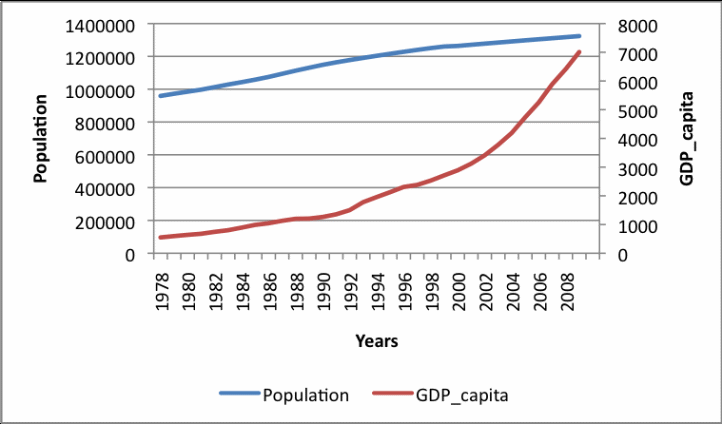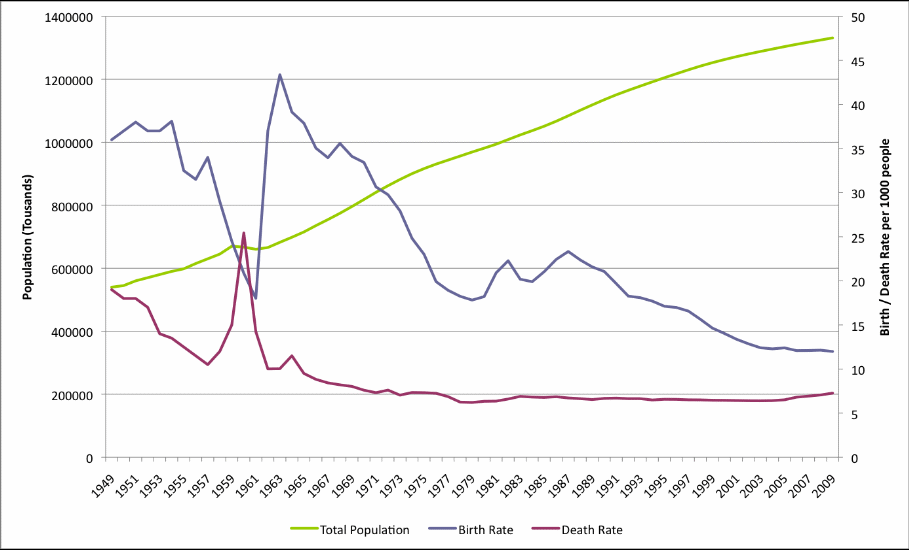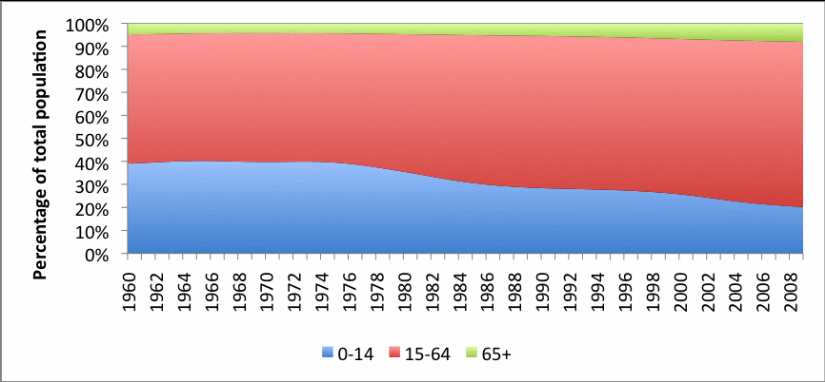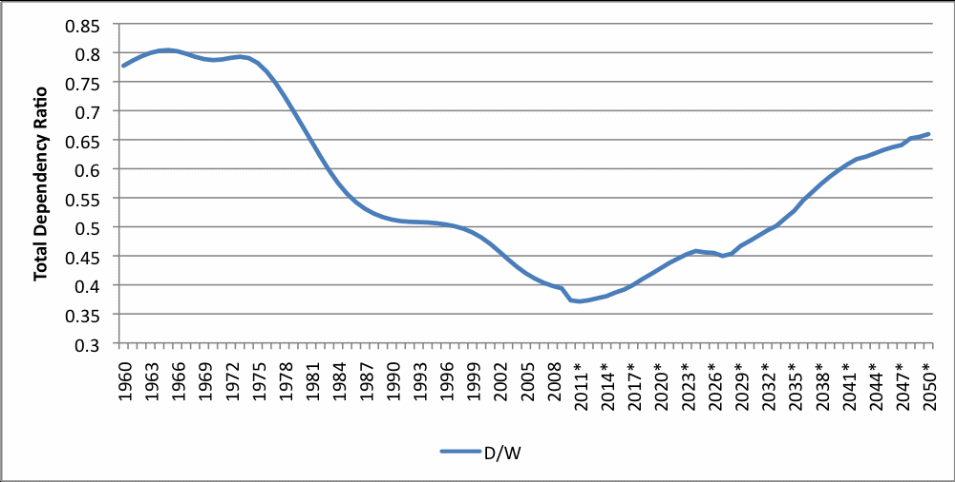Introduction
China’s growing population has elicited widespread concerns within the Chinese government and the policymakers in the past decades. According to the Chinese government, the ever-growing population in the past decades was hampering economic growth with the risk of exhausting the already strained resources. This realization compelled the Chinese government to introduce population-growth control systems, which included family planning and the famous one-child policy. Indeed, the policy was met with far-flung contempt from the human rights activists among other social groups. Nevertheless, the one-child policy was enforced and it played a fundamental role in regulating the Chinese population. This move helped to prevent the dilution of capital, hence stabilizing the economy by creating an incentive to save and invest, thus translating into an increase in the country’s income per capita.
This thesis will be supported with an in-depth analysis by predicting and forecasting the future of the Chinese population and wellbeing given that in 2000, the Chinese government relaxed the one-child policy by allowing some exceptions. The paper will discuss the possible implications of relaxing the policy with respect to the socio-economic wellbeing of the population. This paper will discuss some emerging debates such as whether the Chinese population will be overtaken by that of India, which is ever rising. The other issue touches on whether the one-child policy will alter the socio-economic make-up coupled with how the future Chinese population will appear. The paper will give the past trends in population growth and possible predictions and directions on demographic changes and its future implication on the socio-economic wellbeing of the Chinese population.
Literature review
This paper draws information from the growing volumes of statistical and analytic data and research on the future of the Chinese population. Some researchers hold that China is an emerging superpower based on economic and social stability in the near future courtesy of the declining population. However, this trend is predictable since the economy will have strong capital characterized by enough and skilled labor force. On the other hand, studies predict the collapse of the Chinese socio-economic entity due to the risk of losing young workforce courtesy of the declining fertility and the risk of over-dependency by the aging population, which is less or non-productive. The one-child policy has indeed reduced the Chinese population by millions, hence enhancing the socio-economic welfare, but the question arises on how long the policy will stand since the threat in decline of working population is reckoning in the near future.
Wang, Yong, and Baochang (115) argue that politics played a significant role in the China’s one-child policy. The one-child policy is very consequential to socio-economic undertakings of the 20th century and beyond. Wang, Yong, and Baochang (117) add that the bureaucratic tradition of the Chinese government does not give a chance to public scrutiny or involve the citizens in the policy-making process. Nevertheless, this paper notes that the policy was an appropriate measure to curb the unending population rise in the long term. On the other hand, Cao, Chen, Pang, Zheng, and Nilsson (138) hold that the Chinese population is expected to reach peak in terms of total population, working population, and aging population due to the relaxed policy. The one-child policy will be lacking in bettering the socio-economic welfare since the aging population might create overdependence due to the imbalance brought by decline in fertility. Riley (63), suggests that the Chinese social make-up has been altered by the one-child policy and the future might be undesirable with the aging and dependent population surpassing the productive segment.
Methodology and data analysis
This paper will use literature sources of previously published researches, surveys and conducted interviews of both current and historical information. The paper will explore the available data and generate the relevant information needed to further this thesis.
The majority of the available researches show consistent results by identifying that the Chinese population growth rate was slowed by the population control policies in the short run, thus resulting in socio-economic growth due to the higher output per worker.

Figure 1 above shows how the one-child policy has influenced the Chinese socio-economic wellbeing. The data indicates that the purchasing power of the Chinese population was going up since 1978 to 2006 to match the corresponding increase in population.
However, the growth in socio-economic factors means that population growth will continue to rise despite the one-child policy. The relaxed inclusions in the policy and the stability in the economy means that every family will be encouraged to have a child. Therefore, the anticipated increase in population by other countries like India will not go beyond that of China in the near future.

Figure 2 above shows that the Chinese population continues to rise despite the decrease in birth rates due to the high growth rate of the aging population with a relatively high life expectancy.
The age distribution in the population was highly influenced by the one-child policy among other socio-economic and demographic factor. The aging population was increasing gradually. Due to the decline in the birth rate, the young generation became fewer as compared to the aging population, thus creating a dependency in the economy. Figure 3 below illustrates that the youth dependency ratio fell due to a decline in the youth population to about 20% by 2005. The margin of the aging population is broadening, which means that the dependency ratio of the aged is high. The study assumes that people are eligible to work at age of 16-64, which means that the productive age will narrow in the long term. In addition, in the long-term, the study predicts that the government will have to increase its funding to cater for the aged in terms of pension and health care programs.

Discussion
The future of the Chinese population growth and wellbeing lies not only on the population control policies, but also in other demographic and economic political factors. This paper discusses the research findings by relating the control policies to other socio-economic and political factors influencing the future of the Chinese population. Some of the issues highlighted here include whether China has balanced the distribution of its population and whether it has sufficient population to sustain its workforce needs in the near future. These questions raise concerns among researchers. Historically, China has had the highest population with incorporated strict measures that intrude on personal lives. The one-child policy did not please most people, but the majority conceded that China needed to take quick and stringent measures to slow the population growth rate. Consequently, recent research shows that China might experience slow growth rate in the socio-economic sector due to the low births per woman matched by the higher number of the aging individuals.
The aged population
Recent studies have shown that in the near future, the aging generation will overwhelm its young and productive counterpart. This aspect implies that there will be plenty of young people opportunities, but the aged generation will have constrained lifestyles due to their high population. The health and wellbeing of the aging generation will be compromised due to the competition of resources by this generation as well as the dependency on the few working individuals. In 2010, data indicated that people aged above 60 years occupied an increased 3.3% of the entire population since 2000 (Wang, Yong, and Baochang 118). This realization implies that the government pension scheme and health care system have to be expanded to meet the escalating demand. In a situation where the one-child policy is relaxed, minimal change will be realized in the short run then the trend will resume since the population at childbirth will be rising.

The above figure shows a decline in dependency ratio from 1960-2011, after which a predicted rise in dependency ratio by the aging population is estimated up to 2050. These estimates are done by considering that the one-child policy will be valid for the next few years.
Young population
Decline in the young population has several consequential factors. Apart from reduced labor, the young people entail the ever-active consumers of the market products. The Chinese economy cannot rely on exporting exclusively. The economy produces many products, which must be consumed domestically in large numbers. Since the aged population does not need most of the goods like new cars and new houses, the fact that their population is large, but they are a dependent lot, means that the economy will benefit very minimally from this group of individuals. On the other hand, the economy might as well decline due to the lack of competition in the production sector. Young people are highly active and innovative, which means that the future in the China’s well-being of its population depends on the availability of the young labor (Wang, Yong, and Baochang 121).
Gender imbalance
One-child policy entitled each family to have only one child, but the policy did not address the possible dangers of gender imbalance in a case where families are forced to predetermine the sex of their preference uniformly. The Chinese culture prefers boys to girls. Baby boys had great cultural significance in China and this goal was achieved via the advanced ultrasound technology. This aspect compelled many couples to abort female babies in favor of their male counterparts. This idea was reflected in the 2010 census, which indicated that there were eight boys or more for every one girl in the Chinese population. Wang, Yong, and Baochang (117) suggest that the one child policy should have been phased out since the target reductions in the birth rates were achieved a long time ago. Wang, Yong, and Baochang (117) further indicate that this scenario will worsen gender distribution by creating a male-dominated state with unstable supply of sufficient labor. The predicted change in policy to allow couples with one child to have an extra one might solve the problem of gender imbalance and enable China to maintain its contemporary status as the world’s largest population. The earlier predicted possibility of China becoming a superpower is magnified by the view that the increasing number of men will lead to increase in bachelorhood. To some extent, this aspect might result in an increased focus on criminal intentions by disgruntled people and maybe develop a very skillful military organizations and economic superiority.
End of cheap labor
The large population in China presents the much-needed labor for the industrial and manufacturing sectors. For a long, the political justification for the one-child policy has been based on the booming economy in the country. To some extent, the economic growth has been supported by the availability of affordable labor force due to the high number of young people in the society. Therefore, the reduced birth rate means that labor force will decline and its value go up. Since the economy cannot adjust to the above constraints, it will respond by a slow growth rate. This scenario translates to low living standards by the low earning population due to the decreasing purchasing power.
The rich will continue to amass wealth at the expense of the poor and thus the rift between the two groups will remain wide for a long time to come. This aspect will also have an effect on the global economy since most of the world economies rely on the China’s industries for affordable and quantity goods (De Blij 112). Political legitimacy will be at stake as the economy faces a reduced growth rate. At the same time, demographers and human rights activists will have a platform to debate for the introduction of an empirically supported model, which can reverse the imbalanced population growth (Baochang, Wang, Guo, and Zhang 68).
Social crisis
The Chinese one-child policy has significantly altered the societal structure and the composition of the family unit. The fact that most families would have liked to have at least two children, viz. a boy and a girl, manifests a serious social problem for the entire society (Baochang and Yong 56). Natural catastrophes claim numerous lives of potential workforce. This aspect means that many parents in the old age will have to cope without the help of their children. There is a likelihood that an aged woman of 85 years will see his son die at age of 55 years since women live longer. This aspect means that the Chinese families that have one child may be forced to live without children in the old age, and thus solitude and lack of any form of support will consume them. This aspect causes numerous social crises amongst children, since they know in their absence their parents will be left at the mercies of the government and welfare institutions. There will also be skewed availability of social amenities in the Chinese society. Public structures like schools and health facilities will be too many and public workers serving the young generation will be laid off due to the few demand of these services since the young population will be declining. On the other hand, the old age will have limited or inadequate supply of social amenities such as special hospitals and very few workers will be available to help them in the absence of their kin.
Research limitations
This paper has identified that the majority of the adopted data involves cases of underreporting. Due to the high population in China, most studies rely on representative samples, which compromise the quality and accuracy of the final analysis. The long lasting legal consequences attached to the one-child policy discouraged people from reporting in cases with more than one child for fear of repression. The one-child policy overemphasized achieving short-term population reduction targets by overstating the influence that the policy had on economic growth. The studies also overlooked the impacts on the long-term decline in the birth rates in population growth. The studies did not look at a better or alternative model; for instance, one involving two children born at defined intervals. This kind of a model could be viable for attaining economic growth and at the same time, it would alleviate possible economic decline in the near future since the young workforce supply is sufficient and constant. The studies did not take a comparative analysis on growing economies of other countries, such the United States, that do not use the one-child policy, but still boasts of a stable economy (Kynge 62).
Future trends and challenges
The Chinese population, which is made up of approximately 1.3 billion estimated around early 2000, is expected to increase by 100 million by the year 2050. This number can only be surpassed by India if its population continues to grow at the current rate and China does not lift its one-child policy in the coming years. With the current position of China as an upper-income economy, the idea to move cheap labor force from the rural areas and make employees work for low pay is not executable.
Decline in mortality rate
The China’s mortality rate reduced significantly since the 1950s and the trend keeps on improving every year. The decrease in the birth rates led to improved structures since the resources per person were becoming adequate with time. Improved health care and elaborate health programs were introduced courtesy of the government’s involvement. The current studies incorporate the level of education as a determining factor as well. Women and other caregivers obtained relevant education, which up to date has helped positively the decline in mortality due to lack of basic knowledge. In the future, the mortality rate is expected to decline, which means that a balanced population distribution might be achieved without necessarily increasing the birth rate, but the male dominance will not be altered.
Decline in fertility
Apart from the population control policies, other socio-economic factors have influenced the dynamics in fertility rates in the Chinese population. Such factors include women education levels, marriage, and family earnings. The more economically developed regions of China in terms of education had low fertility levels as compared to the less educated regions. Those with good income had the incentive to raise one child. However, this trend was altered by the one-child policy, which overlooked the individual socio-economic factors and emphasized the population control policies. Regardless of the decline in fertility, the Chinese population will continue to grow only that it will have a high number of aging populations as well as have more males as compared to females.
Marriage
Marriage has been one of the most affected institutions in China. As much as marriage marks the beginning of new life and posterity of generations, these factors are highly overlooked. The Chinese government introduced the one-child policy, thus discouraging marriage at early age and claims that late marriage played a significant role in reducing the country’s population. In addition, the gender imbalance brought about by the one-child policy means that men would not have women to marry. Therefore, very few marriages will happen in the future if the prospected relaxation of the one-child policy is not actualized. This aspect will pose a social crisis and a possible collapse of the Chinese economy and culture.
Migration
Contemporarily, China is faced with a rising number of people seeking to move to new localities. The majority of the migrating population is involved in rural to urban movements. The increasing population in China means limited opportunities especially in the areas characterized by bad terrain and arid and semi-arid zones. People concentrated in cities increase the availability of the labor force, thus leading to dilution of the capital labor. This scenario creates cheap labor, thus allowing the exploitation of workers by the owners of production (Guo 77). Today, this scenario has contributed to the creation of a class system. The migrants find it difficult to adopt new lives in the city, and thus they end up forming the lower class. The long-term urban dwellers occupy the middle class with then the owners of production ruling and dominating the socio-economic system (Yaping and Zhao 1034). In the near future, China will experience class differences and more struggles will emerge occasioned by the emerging capitalistic system.
Inequality
Despite the economic boom especially after the Great Leap and the introduction of the one-child policy in the 1980s, China remained a very poor country with the majority of the rural population being the most affected. Later and up to date, China experiences inequality within its population. Ethno regional, gender, occupational, and class differences highly shape the socio-economic experiences of the Chinese people. The government established socio-economic facilities in the urban areas expecting to expand the projects to the rural area, which caused great imbalance in the Chinese structures (Schramm 39).
Conclusion
Demographers and human rights activists are currently looking to succeed in their ongoing debate to establish a less politicized and an empirically supported structure in the population growth policy making. This move seeks to bring in a highly balanced population growth model. This model seeks to strike balance in terms of age structure, gender, and socio-economic makeup. The population control policies and particularly the one-child policy have reached their targets and for more than 30 years now, no changes have been made to allow families to have at least two children and manage the emerging crises in population age structure. The future population will probably face unstable development due to the low fertility rate, which is has reached replacement level. In addition, the Chinese government still assumes that there is unparalleled underreporting. Factors ranging from education, climatic change, age structure, and gender composition will be essential in determining how the Chinese socio-economic wellbeing will shape in the coming decades. The Indian population will unlikely surpass that of China in the near future even with the one-child policy in place.
Works Cited
Baochang, Gu, Feng Wang, Zhigang Guo, and Erli Zhang. “China’s Local and National Fertility Policies at the End of the Twentieth Century.” Population and Development Review 23.1 (2007): 129-148. Print.
Baochang, Gu, and Cai Yong. Fertility Prospects in China, New York: United Nations, 2011. Print.
Cao, Guiying, Gao Chen, Li Pang, Yan Zheng, and Simon Nilsson. “Urban growth in China: past, prospect, and its impacts.” Population and Environment 33.3 (2012): 137-160. Print.
De Blij, Harm. Why Geography Matters: Three Challenges Facing America: Climate Change, the Rise of China, and Global Terrorism, New York: Oxford University Press, 2005. Print.
Guo, Rongxing. Understanding the Chinese Economies, Oxford: Academic Press, 2012. Print.
Kynge, James. China Shakes the World: A Titan’s Rise and Troubled Future and the Challenge for America, Boston: Houghton Mifflin, 2006. Print.
Riley, Nancy. China’s Population: New Trends and Challenges, Washington, DC: Population Reference Bureau, 2004. Print.
Schramm, Noemi 2011. Population-Control-Policies and their Implications for Economic Growth in China. PDF file. Web.
Wang, Feng, Yong Cai, and Baochang Gu. “Population, policy and politics: how will history judge China’s one child policy.” Journal of Population and Development Review 38.2 (2012): 115-129. Print.
Yaping, Wei, and Min Zhao. “Urban spill over vs. local urban sprawl: Entangling land-use regulations in the urban growth of China’s megacities.” Land Use Policy 2.26 (2009): 1031-1045. Print.
